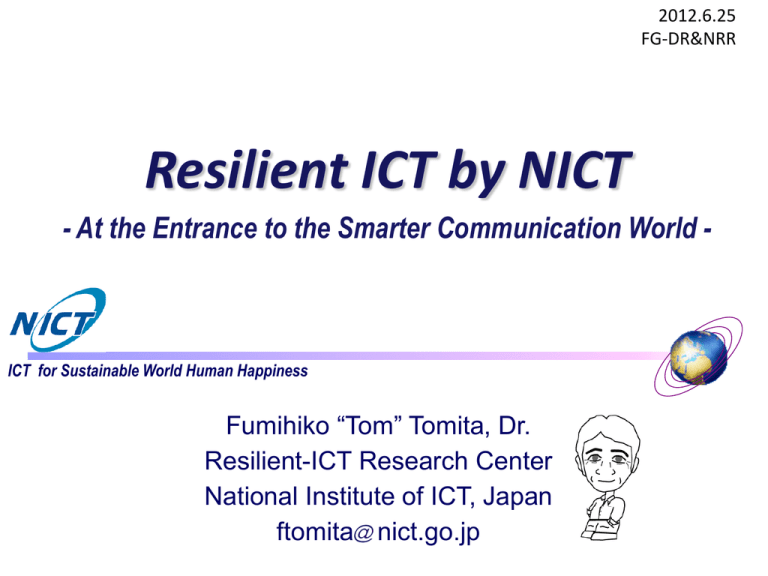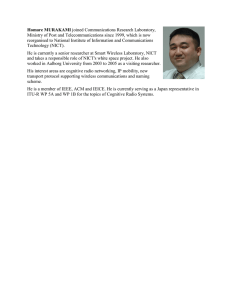Resilient ICT by NICT
advertisement

2012.6.25 FG-DR&NRR Resilient ICT by NICT - At the Entrance to the Smarter Communication World - ICT for Sustainable World Human Happiness Fumihiko “Tom” Tomita, Dr. Resilient-ICT Research Center National Institute of ICT, Japan ftomita nict.go.jp C O N T E N T S 1. Background and Motivation: 3.11 Disaster “Tsunami” wiped out Life Line ICT 2. Challenges: Fiber, Wireless, and Information 3. Robust Network 4. Dependable Wireless Network 5. Anti-disaster Information Distribution Platform 6. Summary 3.11 Disaster and Endurable ICT ICT for Sustainable World Human Happiness Sendai Fukushima Tokyo 500 km 200 km FG-DR&NRR at ITU/Geneva, NICT/Japan, 25 June, 2012 2 Background and Motivation ICT for Sustainable World Human Happiness Earthquakes, and Tsunami, and Fukushima Nuclear Plant Tsunami destroyed away Almost All Network Infrastructure ON THE GROUND 50~60 times Traffic Max. 80~90% Call Control by Operators ~29,000 Base Stations Shutdown Evacuees: 〜340,000 (as of May 2012) Extra-Large Crisis among Residents Lives FG-DR&NRR at ITU/Geneva, NICT/Japan, 25 June, 2012 3 Background and Motivation ICT for Sustainable World Human Happiness Extra-Large Crisis among Residents Lives Communications Cut Off Everywhere including Local government, Emergency Services, etc..... State of Disaster Residents Conditions Importance of ICT Life Line Appropriate Rescue Activity “Connected” and “Unbreakable” Networks FG-DR&NRR at ITU/Geneva, NICT/Japan, 25 June, 2012 4 Challenges: Fiber, Wireless, and Information ICT for Sustainable World Human Happiness Collaboration among NICT・Tohoku Univ.・Industries ① Robust Network Platform Resilient ICT Research Center Dr. Yoshiaki Nemoto Director General of Resilient ICT RC, NICT Universities and Industries ② Dependable Wireless Network ③Anti-disaster Information Distribution Platform FG-DR&NRR at ITU/Geneva, NICT/Japan, 25 June, 2012 Unbreakable Networks, etc. 5 Collaboration Structure ICT for Sustainable World Human Happiness FG-DR&NRR at ITU/Geneva, NICT/Japan, 25 June, 2012 6 Robust Network Platform Dr. Yoshinari Awaji, Director Robust Network Platform Laboratory, Resilient ICT Research Center, NICT e-mail : resilient-mado ml.nict.go.jp FG-DR&NRR at ITU/Geneva, NICT/Japan, 25 June, 2012 7 Emergency Alternative Network System for Disaster-stricken Areas ICT for Sustainable World Human Happiness • This research aims to enable prompt recovery of networks among surviving stations within a period of intensive restoration from three days to one week after the disaster. • By using man-portable equipment and any still available network resources, and ensuring sufficient bandwidth in backbone networks, the emergency alternative network system will be built and offer mobile phone services to a large number of disaster victims. • Thereby, it can be guaranteed that people can equally access to information which is in relation to the disaster situation and relief support, also is necessary for confirming and ensuring safety and reducing damage. FG-DR&NRR at ITU/Geneva, NICT/Japan, 25 June, 2012 8 Emergency Alternative Network System for Disaster-stricken Areas ICT for Sustainable World Human Happiness ① Maintenance personnel can carry the equipment on foot or by bicycle. ② Appropriate measures can be taken in the event of a loss of power at damaged stations. ③ Surviving network resources (buried fiber) can be fully utilized. FG-DR&NRR at ITU/Geneva, NICT/Japan, 25 June, 2012 9 Network Control to Enhance the Effectiveness of the Business Continuity Plan (BCP) ICT for Sustainable World Human Happiness • The nationwide spillover effects of network congestion will be minimized upon the occurrence of a significant disaster. • Also, the deterioration in the quality of network services will be suppressed to the extent possible by switching to alternate routes in a small amount of time, changing the usage of lines, and providing remaining network resources to build new service networks for recovery from the disaster. • Sufficient communication capabilities for disaster-stricken areas will also be secured. FG-DR&NRR at ITU/Geneva, NICT/Japan, 25 June, 2012 10 Network Control to Enhance the Effectiveness of the Business Continuity Plan (BCP) ICT for Sustainable World Human Happiness • Congestion in disaster-stricken areas without infrastructure damage can be alleviated immediately. • Changes to network resources and services can be made on a timely basis. • Using rebuilt networks, the spillover effects of congestion can be avoided. FG-DR&NRR at ITU/Geneva, NICT/Japan, 25 June, 2012 11 Dependable Wireless Networks in Disasters Wireless Mesh Network Laboratory, Resilient ICT Research Center Tohoku Univ. RIEC Bldg. # 1 N302, 2-1-1 Katahira Aoba-ku, Sendai 980-0812, Japan e-mail: resilient-mado ml.nict.go.jp FG-DR&NRR at ITU/Geneva, NICT/Japan, 25 June, 2012 12 Dependable Wireless Networks in Disasters ICT for Sustainable World Human Happiness Summary • The cellular phone’s base station of 10,000 or more stopped just behind the East-Japan earthquake due to the breakdown and the power failure, and the telephone call limitation of about 90 % at maximum was executed according to the rapid increase of the communication traffic. • Many of wired communication networks and the emergency municipal radio communication systems were destroyed, and the fragility to the disaster of the communication network was highly exposed. • As a result, it interfered to resident's safety and the grasp of the struck situation, and also became fatal in the disaster relief activity such as circulation of medical services and rescue supply etc. by government and public organizations. • This caused huge extensive social and economic losses. • To realize strong wireless networks in disasters, we study both satellite communications and wireless mesh networking technology, especially for technologies regarding full-auto earth station for WINDS satellite, wireless mesh network system by bridging satellite, unmanned aerial vehicle (UAV), and ground wireless nodes. FG-DR&NRR at ITU/Geneva, NICT/Japan, 25 June, 2012 13 Dependable Wireless Networks in Disasters ICT for Sustainable World Human Happiness Targets Full-Auto Earth Station for WINDS Satellite • To achieve satellite communication that realizes easy handling and sure operation, a full-auto portable earth station is developed. Wireless Mesh Network System by bridging Satellite, UAV, and Ground Wireless Nodes • The traffic control of the limited communication infrastructure is a big problem against a rapid traffic increase in the time of disaster. • To solve this issue, wireless mesh network system by bridging satellite, UAV, and ground wireless nodes having flexible traffic control technology is developed. • Also we will demonstrate actual useful applications on the developed wireless systems assuming disaster situations. FG-DR&NRR at ITU/Geneva, NICT/Japan, 25 June, 2012 14 Dependable Wireless Networks in Disasters ICT for Sustainable World Human Happiness Communications satellite Wireless system by bridging satellite, UAV and ground nodes UnmannedAerialVehicle (UAV) Full-auto earth station Connected isolation regions such as mountainous districts and islands - Strong system by wireless mesh networking - Private wireless mesh network that offers social application in peacetime Reliable system that accommodates sensor information Mobile node offering application both in peacetime and emergency Disaster area is covered by portable node installation Vital data transmission to hospital Antidisaster headquarter Portable node Refuge B Refuge A - Safetyconfirmation between refuges - Smooth distribution for supportgoods and information - Healthmonitor of evacuee FG-DR&NRR at ITU/Geneva, NICT/Japan, 25 June, 2012 Tele-monitoring by sensors, RFID etc. 15 Anti-Disaster Information Distribution Dr. Kentaro Torisawa Director of Information Distribution Platform Laboratory, Resilient ICT Research Center, NICT e-mail: resilient-mado ml.nict.go.jp FG-DR&NRR at ITU/Geneva, NICT/Japan, 25 June, 2012 16 Anti-Disaster Information Distribution ICT for Sustainable World Human Happiness Summary • One of the lessons of the Great East Japan Earthquake was that it is quite difficult for people to quickly and properly grasp the information in disaster situations. • According to several official groups who performed rescue and relief activities in areas affected by the Great East Japan Earthquake, many problems occurred due to lack of effective information sharing. • In this research, we are developing an anti-disaster information distribution platform that collects and organizes a vast amount of information concerning disasters using the information analysis technologies we have developed so far, in order to provide useful information that facilitates the grasping of the situation and better decision-making. FG-DR&NRR at ITU/Geneva, NICT/Japan, 25 June, 2012 17 Anti-Disaster Information Distribution ICT for Sustainable World Human Happiness Technical Subjects and Targets • We are going to release our anti-disaster information system running on large-scale cluster machines at Resilient ICT Research Center in Tohoku University in 2014. • The system combines the technologies under NICT’s questionanswering system (Ikkyu), information analysis system (WISDOM), and Discourse Map of Tohoku University, to enable efficient information organization in disasters and also to facilitate information reliability judgment from many viewpoints, and as a result, to suppress harmful rumors during and after the disasters. • In addition, we promote the utilization of the cluster machines at Resilient ICT Research Center by researchers from universities and institutions to establish a wide range of joint research and development community for anti-disaster information technologies. FG-DR&NRR at ITU/Geneva, NICT/Japan, 25 June, 2012 18 Anti-Disaster Information Distribution ICT for Sustainable World Human Happiness FG-DR&NRR at ITU/Geneva, NICT/Japan, 25 June, 2012 19 Summary ICT for Sustainable World Human Happiness • While information and communication systems, in the East Japan Great Earthquake on March 11 in 2011, have been severely damaged and did not work sufficiently, the importance as social infrastructure has been strongly recognized. • Under close collaboration with Tohoku University, National Institute of Information and Communications Technology (NICT) established the world's leading research center named “Resilient ICT Research Center” on April 1st 2012 in Katahira Campus of Tohoku University. • The center aims to realize resilient ICT technologies and regenerate local economic activities in disaster areas by promoting collaborative research among industry, academia and government. FG-DR&NRR at ITU/Geneva, NICT/Japan, 25 June, 2012 20 Another Summary ICT for Sustainable World Human Happiness • Increasing Dependence on ICT • Changing Disaster Situation in Time and Space • Emergency Hyper Operations (National Inst.) + Collaboration with Operators • Both High-Tech and Low-Tech ICT + Mobility • (Usual) Normal Time Operations FG-DR&NRR at ITU/Geneva, NICT/Japan, 25 June, 2012 21
